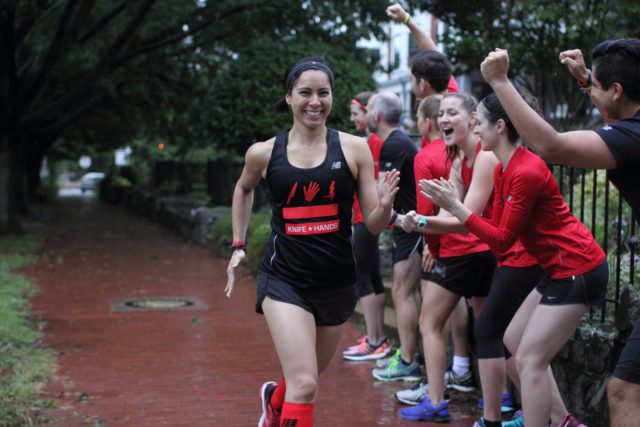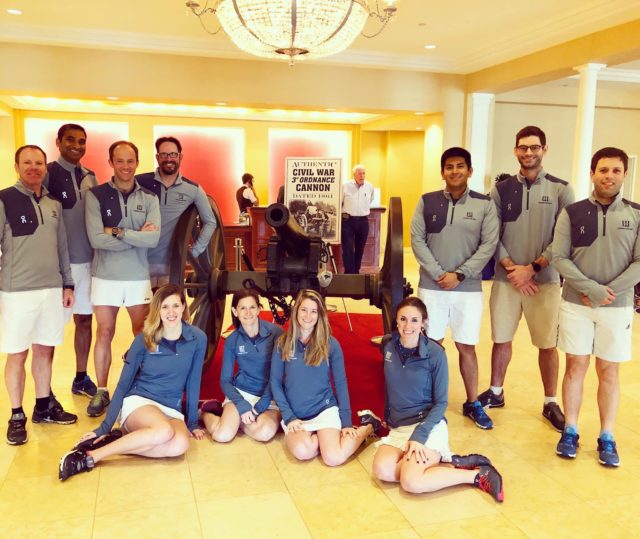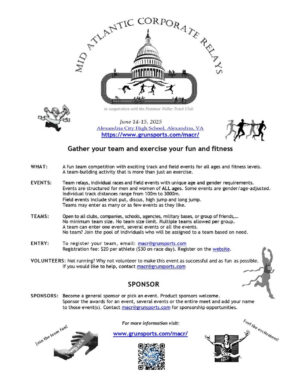
Covering 18 miles at once may not sound difficult to many runners, but it becomes far more difficult when those 18 miles are split up over the course of the three separate runs without proper recovery time in between, lack of sleep or square meals. Plus at least one of those legs takes place in the middle of the night.
Road relays like Ragnar or American Odyssey have become popular staples in the running world. These 24-hour, 12-person races involve runners taking turns running three legs of various lengths across 100+ mile distances across either road or trails. Some teams run short-handed for an extra challenge.
The idle runners follow their active runner in a van, and wait at an exchange zone until it is time to hand off the running responsibility. Trail races, on the other hand, follow loop courses, with participants staying in a camp or village until it is time for their leg.
Elyse Braner, outreach coordinator for Pacers Running, has captained over 30 relay teams and runs anywhere from two to four relays a year. Her favorite is the American Odyssey relay, which runs to D.C. from Gettysburg in April.
“I like it because it’s small and locally-owned and friendly and a great beginner’s relay,” she says. She has run the American Odyssey relay 10 times.
Running a relay can be a different, sometimes daunting experience for those who are new to the event, even for people with strong running backgrounds. Without proper recovery time between legs, it can be hard for runners to understand what they will be experiencing during the relay. Braner says if you want to get a feel for what running a relay is like, she suggests trying three hard runs within 24 hours.
“The common advice on that is wake up in the morning, do a six-mile run and do another six-mile run later that evening, then wake up the next morning and do another one. Simulate a tempo or a faster pace.”
That, she says, is the best way to simulate a relay experience.
But running alone is not the only challenge that comes from a relay. Sleep deprivation is another aspect that first-timers can struggle with, which is harder to prepare for.
“You can’t really train up for sleep deprivation,” Braner says. “Some people can sleep really well in the van. I’m one of those people. But [most people] have to go 24 hours with really no sleep. People are going to get cranky.
“You’re one of 12 people and you want to keep it a pleasant experience. [You] kind of have to fight though [the sleep deprivation].”
Nutrition is another area where first-time relay runners can run into problems. “[During] my first relay, I just ate PowerBars the whole time. I had to train myself to eat real meals in between. I think it’s important for people to eat real meals, not just live on Gu.”
Braner suggests that people looking to do their first relay start with a half-day relay, which often have one-leg segments. The half-day experience can be far less intimidating than the 24-hour races.
This fall, Braner will serve as captain of teams for the Blue Ridge Relay, Rock the Creek Relay and the Growler Relay.
To be “captain” of a relay team is an important job. The captain does everything from selecting the team, coordinating registration, designing team uniforms, providing race travel logistics, writing packing lists, gathering supplies, setting up fan decorations, arraigning team sponsorships, and putting contingency plans in place in the event that runners get injured.
“You know, overall making sure everyone has a great experience,” she says. “What’s most important for me is that it’s fun but also that it’s well organized.”
Braner says another role of the captain is to set a tone for the team. “On the outset, are we in it to win it or are we going for a more social experience?”

Another relay captain, Natalia Machuca, has lived in DC since 2004. She describes herself as a “late bloomer runner”, who started running just before turning 30. She started running with the Potomac River Running in Cleveland Park. Though Potomac River Running no longer has a location there, she still keeps up with many of her running friends from those days.
Machuca started the Knifehands in 2013, a group that started as a silly name for her 2013 Washington DC Ragnar team. Many of the Knifehands participants came from the Cleveland Park group.
“I never expected [the name Knifehands] to really stick but people loved it and we’ve been doing these relays since 2013, pretty much one every year,” she says. “Even friends who moved away to other states still come out to meet the team anywhere.”
This year Machuca and the Knifehands team participated in the So-Cal Ragnar Relay in California.
As captain, Machuca says she prides herself on her organization.
“I put a lot of thought into having the runners just worry about running and not worry about anything else when on the relay. And [I do] all the planning that goes around it like hotels and transportation and how much food we are going to have. Over the years, I’ve really streamlined what we need and what we don’t need,” she says. “Things that [seem] obvious can get overlooked, like how close are we to a Costco to get water and Gatorade? And little things like how many salty foods or sweet foods do we have?”
Machuca runs the team, but has a deputy that she often runs ideas by. Though she says that at this point they trust her enough to let her make the decisions. “I feel like I’m planning a vacation and all they do is say yes and then they reimburse me at the end of all the running.”
She appoints a van “communications officer” for both vans as a point-of-contact. When that person is running, someone else takes over the role. She learned this lesson the hard way. “There was one year I was sick and it was the middle of the night and we almost missed our next change because of not communicating well with the other van. So now I’ve charged [someone] in the van as a communications officer.”
Though both Braner and Machuca have participated in and captained numerous road relays, neither have had much experience with trail relays. Braner ran in one trail relay, the West Virginia Trail Ragnar, and Machuca has never done one. Both cite the camping aspect of the event as the reason they do not prefer the trail relays.
Fredericksburg’s Jack Rock, on the other hand, says he prefers the trail relays to road relays. His first relay was the Richmond Trail Ragnar Relay in 2017.
Since trail relays are done in loops, each runner runs the same route. Rock enjoys the consistency of it rather than the variation that comes from road races, where each runner runs a different distance and elevation.
Rock also likes the camping aspect of the trail relays as opposed to the van. “[In road relays], you’re in a van the whole time. The trail one, you set up a tent and you’re in the same place,” he says. “The village has food trucks and cool stuff and it’s a more fun environment where you get to camp out in a tent and not a van.”
When asked why he thinks many people prefer the road relays, Rock says, “Some people don’t like trail running. Trail running can be muddy.”
Rock also says he finds that road relays tend to be more competitive, whereas the trail races tend to be less intense.
Braner agrees with Rock on that point. “If you’re looking for more of a casual, relaxed experience between running your legs, then you’re going to prefer the trail runs or trail Ragnars,” she says.
Though both road and trail relays are popular in the running community, Braner notes that she does not see relays as a growing trend in general, but rather an event that has stagnated in popularity.
“In my opinion, [interest in relay racing] has stagnated. Within the running groups, I don’t see as many people putting together the teams. I think a lot more people are willing to join a team instead of organize them. But I do think the popularity of them has stagnated a little bit.”
She goes on to say that she notices a lot of the same faces coming back to these relays over and over again.
Although she views relay races as something that has stagnated, she hopes to see them grow in popularity. “If people haven’t tried relays, they are such a great experience. You are going to bond with people whether they are friends or strangers.”
Machuca agrees. She views relays more as a bonding experience than as athletic events. “I think we have all become better friends for doing this together.”
If someone is interested in joining a relay but does not have a team, there are many ways for runners to find teams.
When Machuca ran her first relay, she ran with a group of friends where she did not know most of the people involved, which is common.She recommends if someone is interested in participating in a relay, but may not have too many running friends, to check social media sites.
“Each of the races have specific pages on Facebook and a lot of people go there to look for people to jump on their teams. You’ll see people who are more comfortable [meeting new people]. A lot of people write, ‘I run at this pace’, or they will be really specific and say, ‘I need a woman to run leg X.’ I think those social media groups are a good way to meet people.”
In the end of it all, Braner says the strangest part of running relays is coming home after the event is all over.
“When the relay ends and you’re back at your apartment by yourself after staying in a van with 12 people, you wonder where are all your friends and there is kind of a sense of loneliness after the relay ends.”
Recent Stories
Looking for our race calendar? Click here Submit races here or shop local for running gear
Hero Dogs 5K9
Hero Dogs Inc will host its 5th Annual 5K9 race at the Congressional Cemetery on Saturday, May 17th, beginning at 8 am. There will also be a 1K Fun Run. The 1K Fun Run will start at 8 am sharp
Mid Atlantic Corporate Relays
Team relays, individual races and field events with unique age and gender requirements. Events are structured for men and women of all ages.
Some events are gender/age graded. Individual track distances range from 100m to 3000m.
Field events include shot






